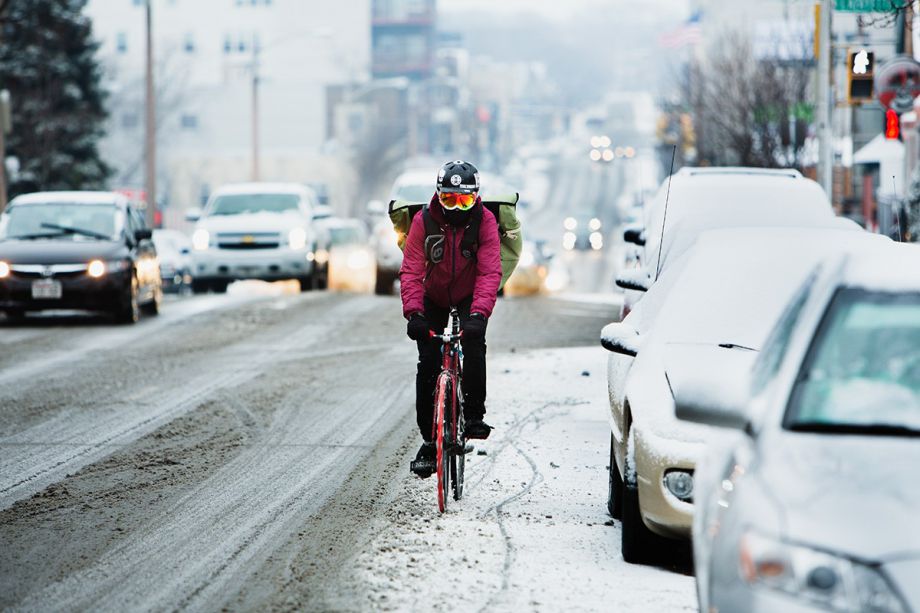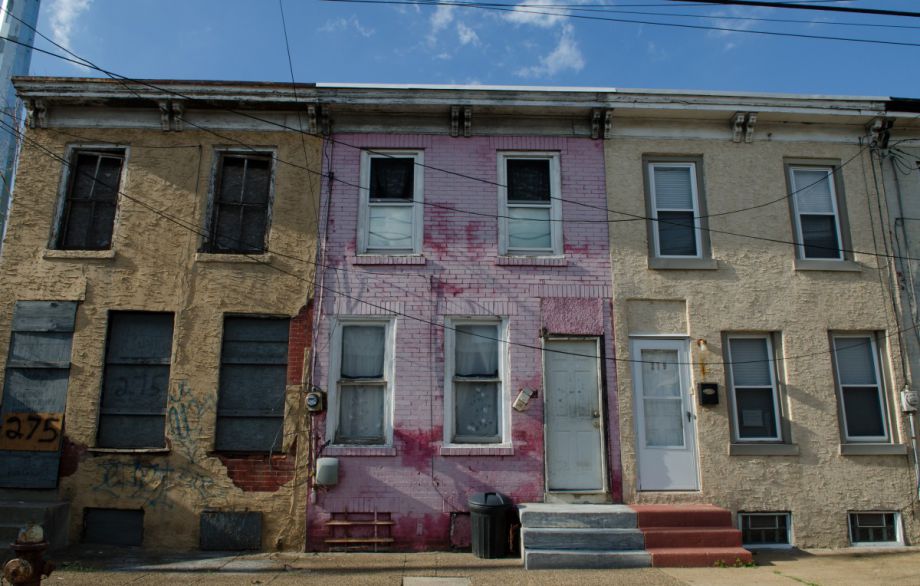Read This If You’re Thinking About Riding Your Bike in the Snow

Cyclist Nick “Mint” Costanzo, a delivery man with Flavor Cycle, bikes down a snowy Milwaukee street. (Photo by Peter DiAntoni)
It’s 10 below freezing. The wind is whipping. Snow is starting to fall.
For a growing community of winter cyclists in Milwaukee, that sounds like the perfect weather to bring out the bike.
Year-round cycling is on the rise in the Midwest city — where winter lows can go south of zero. It’s a trend that debunks critics around the country who say bike lanes will only be used in fair weather.
Dave Schlabowske, deputy director at the Wisconsin Bike Federation, says he’s seen a drastic change in the last 15 years that he’s been biking to work through the winter.
“Back then, if I saw somebody I didn’t know biking in February, I’d email the six other people I knew who biked in the winter and tell them about it,” he says. “Now I see people out there all the time.”
In snowy months, the city government’s top priority for helping bikers is simply keeping the streets plowed, including the city’s 85 miles of bike lanes (almost 30 miles of which were put down in the last two years). Bike racks on the front of every city bus make it easier for riders to combine different modes of transportation.
“Winter’s just a fact of life in Wisconsin — it is what it is,” says Kristin Bennett, the city’s bicycle/pedestrian transportation coordinator. “People have the same travel needs no matter the time of the year.”
While the city doesn’t have data on winter bikers — it’s working to install bike traffic counters this year — anecdotally, almost everyone agrees winter biking is on the rise.
One innovation making winter biking easier is the popularity of fat tire bicycles — souped-up mountain bikes equipped to ride on snow-covered trails. There are five different bike companies in Wisconsin that now produce fat tire bikes.
“It’s taken off,” Bennett says. “Everyone’s asking about them.”
Sales of fat tire bikes, which range from $250 to $5,500 in price, totaled $8.8 million across the country last year, the Milwaukee Journal Sentinel reported.
While he says overall winter business is currently slow at Crank Daddy’s Bicycle Works, co-owner Eric Kuhagen says more people have been buying winter gear and fat tire bikes than in past winters. Thick gloves and warm booties that go over shoes are among the top-selling items.
“Riding your bike in any weather, it’s not about the weather, it’s about the proper gear,” Kuhagen says. “That’s true for any sport, not just cycling.”
Milwaukee isn’t the only frigid Midwest city where bikers aren’t afraid of the winter. In her first proclamation in office last year, Minneapolis Mayor Betsy Hodges named January 3rd “Winter Biking Day,” calling Minneapolis cyclists “tougher and much better looking than bicyclists from all those wimpier cities.” And this year, for the first time, the streets department in Calgary has been directed to clear priority cycling routes when snow falls.
Not everyone is on board with the winter biking trend. “In the winter, it won’t even be used,” is a common refrain from many bike lane opponents. One upstate New York mayor suggested last year that winter bikers “should be arrested” because they’re putting others in danger.
Schlabowske says it’s the opposite — while commuting to work on his bike, he has helped drivers push cars out of ditches by the side of the road.
“I haven’t driven a car to work in 15 years,” he says.
One small business taking advantage of the winter months is Flavor Cycle, a food delivery company that brings Milwaukeeans restaurant meals by bike. More orders come in as the temperature drops, and the company’s fleet of 18 contracted delivery people typically clock 30 to 40 miles every six-hour shift.
“When one day you’re out in subzero windchill, and the next day it’s 10 degrees, 10 degrees feels fantastic,” says owner Peter DiAntoni. He also jumps in the saddle to make deliveries. “Once you’ve hit the hardest part, everything’s easier.”
But like most winter bikers — and the rest of the city — Flavor Cycle will close shop during especially nasty snowstorms.
“Everyone who’s doing this job loves it, they love the challenge,” DiAntoni says, but “we’re not martyring ourselves.”
Casey Tolan is an urban studies student at Columbia University. He has written for CNN International, the New York Daily News, Gotham Gazette and other outlets.
4 Cities Step Up Fight Against Blight

Last week, Camden, New Jersey, above, kicked off an ambitious plan to take down 600 of the city’s most derelict buildings. (Photo by Blake Bolinger)
Cities across the country continue to look for ways to tackle blight. Here, a couple of recent developments worth watching.
Camden Okays Teardowns
Last week, Camden, New Jersey, kicked off an ambitious plan to take down 600 of the city’s most derelict buildings. Although the clearing process is a welcomed one, the demolition has gotten off to a rocky start.
Last week, Camden, New Jersey, kicked off an ambitious plan to take down 600 of the city’s most derelict buildings. Although the clearing process is a welcomed one, the demolition has gotten off to a rocky start.
The Courier-Post did some digging to show how inefficient the process has been, and where the city government could be making and saving money.
1510 Louis Street, the first house to be demolished, was abandoned by a former city employee who the paper was able to track down in less than two minutes. According to the Courier-Post, the city hasn’t taken neglectful, non-taxpaying owners to court since 2010. Meanwhile, it will be paying the demolition company $15,206 per building out of a $970,000 Community Development Block Grant.
Detroit Empowers Neighbors
Earlier this month, the Detroit Land Bank Authority held a fair allowing homeowners to apply for and purchase the vacant lots adjacent to their homes. Like their blexting appthis is just one of the inventive strategies the land bank is implementing to return lots back to productive use.
Earlier this month, the Detroit Land Bank Authority held a fair allowing homeowners to apply for and purchase the vacant lots adjacent to their homes. Like their blexting appthis is just one of the inventive strategies the land bank is implementing to return lots back to productive use.
The program has only brokered the transfer of a couple hundred lots out of the tens of thousands of properties the land bank has in its portfolio, but these fairs offer a crucial opportunity for Detroit residents to invest in their neighborhoods.
“There’s a story to every one of these,” Mayor Mike Duggan told The Detroit Free Press. “People want to put gardens next door. They want to put a swing set next door. They want to fence off a lot because people have been dumping tires. It gives people control over their own neighborhoods. It’s very exciting.”
Like Camden, Detroit has struggled with identifying and contacting the owners of the abandoned properties. The city is transferring 40,000 properties to the land bank, which has hired a team of lawyers to take on the sluggish process of winning title clearances.
Memphis Law Students Bust Owners
Memphis’ law division has teamed up with the University of Memphis Law School to create a clinic that will give students hands-on blight-fighting experience. The students will work with code enforcement officers to help prepare civil lawsuits and prosecute neglectful owners (likely saving the city some money in the process). According to Neighborhood Preservation Clinic officials, Memphis files more of these types of lawsuits than any other city in the country.
Memphis’ law division has teamed up with the University of Memphis Law School to create a clinic that will give students hands-on blight-fighting experience. The students will work with code enforcement officers to help prepare civil lawsuits and prosecute neglectful owners (likely saving the city some money in the process). According to Neighborhood Preservation Clinic officials, Memphis files more of these types of lawsuits than any other city in the country.
Dallas Considers Utility Upgrades
Dallas Mayor Mike Rawlings has stayed true to his promise to demolish 250 neglected buildings. In an editorial last week, The Dallas Morning News offered a couple of additional suggestions for the city to get the lots back up and running while the dirt is still spongy.
Dallas Mayor Mike Rawlings has stayed true to his promise to demolish 250 neglected buildings. In an editorial last week, The Dallas Morning News offered a couple of additional suggestions for the city to get the lots back up and running while the dirt is still spongy.
As outdated infrastructure can be a headache for potential developers, the paper suggests the city could synchronize its normal upgrades to its sewer, water and electrical infrastructure with the development of vacant lots. It could also offer a multi-year tax abatement formula for property buyers building on infill sites, especially since the city would not be collecting taxes on the property anyway. Finally, moving forward, the city could begin putting a higher priority on preserving structurally sound buildings located in historic districts.
The Equity Factor is made possible with the support of the Surdna Foundation.

Alexis Stephens is Next City’s urban economics fellow. She’s written about housing, pop culture, global music subcultures, and more for publications like Shelterforce, Rolling Stone, SPIN, and MTV Iggy. She has a B.A. in urban studies from Barnard College and an M.S. in historic preservation from the University of Pennsylvania.



No comments:
Post a Comment
Please leave a comment-- or suggestions, particularly of topics and places you'd like to see covered